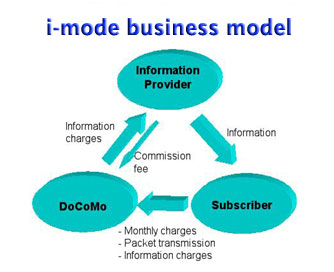A Cambridge perspective
on the digital world



March 2002
In a significant step forward, NEC has recently received its first orders from Netherlands-based operator KPN for handsets to support the European rollout of i-mode. Meanwhile, as NTT DoCoMo's shares made their debut on the London Stock Exchange, DoCoMo has indicated it will pursue an agressive expansion policy in Europe, including equity partnerships and alliances in a number of countries.
i-mode is the outstanding success story of mobile multimedia, having reached more than 30 million subscribers in Japan in the three years since its launch. Nowhere else in the world has non-voice mobile experienced a comparable success.
i-mode's European launch is planned initially for Netherlands and Germany, followed shortly by Belgium.
Some commentators have doubted whether the Japanese success can be reproduced elsewhere - citing reasons ranging from the low base of Internet usage in Japan, to the fact that Japanese commuters spend long hours on public transport, to explain why the success of i-mode is a specifically Japanese phenomenon that will not work anywhere else. There are specific differences in Japan - one reason why i-mode has taken so long to appear elsewhere - but in our view, too much has been made of this. The basic business concept of i-mode has not been tried outside Japan: the WAP services introduced in Europe are, at least as far as consumers are concerned, a very pale imitation. Provided NTT DoCoMo and its European partners have done their job effectively, i-mode stands every chance of becoming an outstanding success in the rest of the world, too.
In particular, the NEC N21i clamshell-style handset, with its 1.9 inch colour LCD screen, will be a revelation in the European market. Colour handsets are only now starting to be introduced in Europe; they have been a standard part of the 'i-mode experience' for some time. The clamshell form factor, and the supremely simple user interface - designed for naive users - will be a welcome innovation for those used to struggling with the complexities of WAP. While WAP was designed to be technically innovative, little attention was given to usability. Consequently each handset manufacturer has taken a different approach. Some of the results could be taken as textbook examples of how to confuse the public.
One of the biggest problems of WAP was that it was built on top of the European GSM cellular network - digital, but designed to carry voice calls, not data. As a result, setting up a WAP session to perform the simplest task could easily take a minute or more... by which time most users had lost interest.
DoCoMo and KPN have, very wisely, waited until GPRS (2.5G) technology was widely deployed. i-mode in Europe can therefore be experienced from the start as an 'always on' service, as it is in Japan. i-mode gives the user an effectively instant response: this is a key part of its appeal. We suspect that DoCoMo was not happy to launch a service with a less-than-perfect user interface: an indication of the attention to detail that has characterised the i-mode approach from the start.
GPRS has been widely deployed by European operators, on top of the existing GSM network. It is a significant technical innovation, allowing 'always on' transmission of many kinds of data, but it has not been accompanied by a new set of services to make it attractive and interesting to consumers. i-mode has arrived at just the right time to give a much-needed boost to GPRS deployment: making it clear to users just what all the fuss is about, in terms they can understand.
Details of services and business relationships for European i-mode have not yet been released; but if they follow Japanese practice this may prove to be the most significant innovation of all.
In Europe, operators have been unclear whether they should be content providers, carriers of telecommunications traffic - or an uneasy mixture of both. This has made relationships with third party content and application providers difficult. Not a few third parties have run out of patience - and money - waiting for the situation to clarify.
DoCoMo has, from the start, established a productive business partnership with third parties, which has encouraged them to invest in content, applications and services for delivery over i-mode. Without this, the service would not have taken off. DoCoMo's role is very clear and very consistent, which makes business negotiations easy.
 DoCoMo
pockets all the telecommunications charges, and a commission in return for
collecting value-added service subscriptions. The lion's share of value added
information charges go to third parties. This is a powerful incentive to new
business creation; and this 'virtuous circle' in which everyone - DoCoMo,
the subscriber and the information provider - wins, has fuelled the growth
of i-mode to the level it has reached today.
DoCoMo
pockets all the telecommunications charges, and a commission in return for
collecting value-added service subscriptions. The lion's share of value added
information charges go to third parties. This is a powerful incentive to new
business creation; and this 'virtuous circle' in which everyone - DoCoMo,
the subscriber and the information provider - wins, has fuelled the growth
of i-mode to the level it has reached today.
This business model works. Other models have been tried elsewhere, but so far nothing else has shown the same level of success.
European operators are, naturally, not keen for an overseas operator such as DoCoMo to come in and take their business. Licence conditions in most countries - not to mention the prohibitive cost of new infrastructure - in any case preclude a new entrant. But if DoCoMo can add value to an existing operator's business, in return for a share of new income and profits, this must seem an increasingly attractive option. DoCoMo's strategy of taking an equity stake in key European operators makes perfect sense.
So far, operators in the rest of the world have failed to reproduce i-mode's success, working on their own. We think the basic lessons of i-mode are clear (see Learning from i-mode ), but implementing them is clearly not trivial. An injection of what has made i-mode successful, into some of Europe's leading operators, must seem an attractive proposition for consumers and managers. It will also give some hope to shareholders who have seen the value of their investment take a dramatic tumble in recent months. If i-mode can show how it's done, in Europe as well as in Japan, it will benefit the whole industry, and help to restore confidence in the telecommunications future. A leading UK operator recently estimated that 75% of new revenue growth in mobile over the next five years will come from data services: if so, a change of approach is called for. As an example of how to move beyond voice telephony into the multimedia future, and make money from it, i-mode will have a continuing role in Europe as well as in Japan.
NEC's new European i-mode handset will be unveiled at the CeBIT 2002 show in Hannover this month. If the reaction is positive, we expect DoCoMo Europe's phone to be very busy in the months ahead... and some interesting developments in the shareholdings of major European operators.
